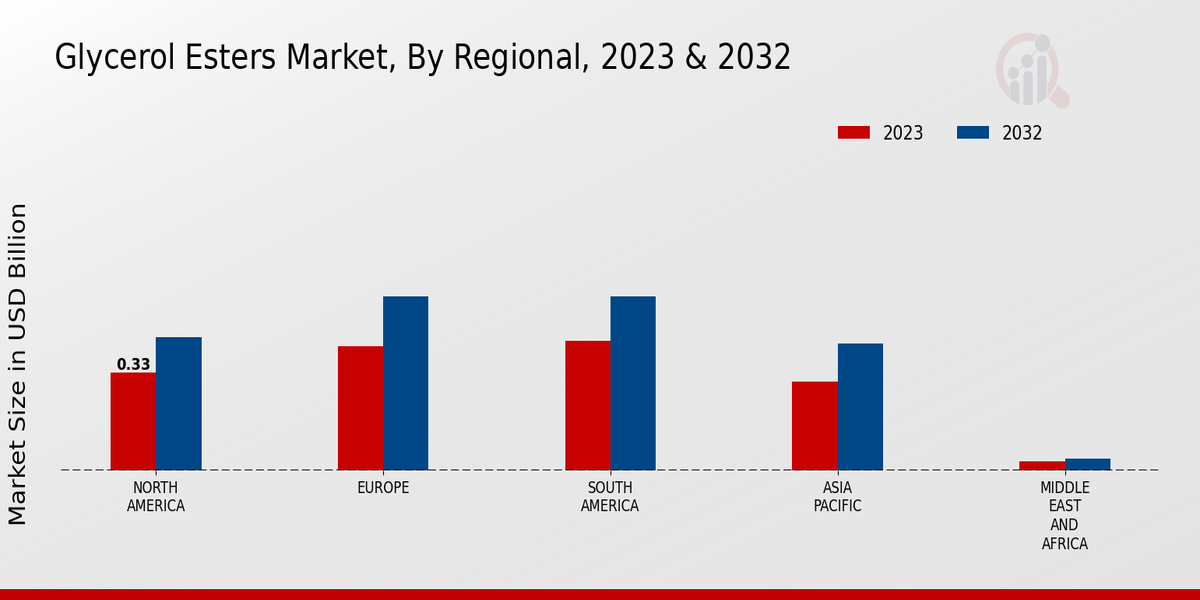Market Growth Projections
The Global Glycerol Esters Market Industry is projected to experience robust growth, with estimates indicating a market value of 1.62 USD Billion in 2024 and a potential increase to 2.43 USD Billion by 2035. This growth trajectory reflects a compound annual growth rate of 3.75% from 2025 to 2035. Factors contributing to this expansion include rising demand across various sectors, technological advancements, and a growing emphasis on sustainability. As industries recognize the benefits of glycerol esters, the market is likely to attract increased investment and innovation, further solidifying its position in the global economy.
Rising Demand in Food Industry
The Global Glycerol Esters Market Industry experiences a notable surge in demand driven by the food sector. Glycerol esters serve as emulsifiers, stabilizers, and thickening agents in various food products. As consumer preferences shift towards healthier and cleaner labels, manufacturers increasingly incorporate glycerol esters to enhance product quality. This trend is reflected in the projected market value, which is expected to reach 1.62 USD Billion in 2024. The food industry’s focus on natural ingredients further propels the growth of glycerol esters, indicating a robust future for this segment within the Global Glycerol Esters Market Industry.
Diverse Applications Across Industries
The Global Glycerol Esters Market Industry is characterized by its diverse applications across multiple sectors, including cosmetics, personal care, and industrial applications. Glycerol esters are valued for their multifunctional properties, serving as emulsifiers, surfactants, and stabilizers. This versatility enables their use in a wide range of products, from skincare formulations to industrial lubricants. The increasing demand for multifunctional ingredients in various industries supports the growth of glycerol esters, indicating a promising outlook for the market. As industries continue to innovate and expand, the role of glycerol esters is likely to become even more pronounced within the Global Glycerol Esters Market Industry.
Growing Applications in Pharmaceuticals
The Global Glycerol Esters Market Industry benefits from expanding applications in the pharmaceutical sector. Glycerol esters are utilized as excipients in drug formulations, enhancing solubility and bioavailability of active ingredients. The increasing prevalence of chronic diseases necessitates innovative drug delivery systems, where glycerol esters play a crucial role. As the pharmaceutical industry evolves, the demand for glycerol esters is likely to rise, contributing to the market's growth trajectory. This sector's expansion aligns with the overall market forecast, suggesting a potential increase in market value to 2.43 USD Billion by 2035, highlighting the importance of glycerol esters in modern pharmaceuticals.
Sustainability and Eco-Friendly Products
The Global Glycerol Esters Market Industry is increasingly influenced by a shift towards sustainability and eco-friendly products. Consumers and manufacturers alike are prioritizing biodegradable and renewable ingredients, leading to a heightened interest in glycerol esters derived from natural sources. This trend aligns with global sustainability goals, prompting companies to innovate and develop greener alternatives. As a result, the market is likely to witness a compound annual growth rate of 3.75% from 2025 to 2035. The emphasis on sustainability not only enhances the appeal of glycerol esters but also positions them favorably within the broader context of environmentally conscious consumer behavior.
Technological Advancements in Production
Technological advancements in the production of glycerol esters significantly impact the Global Glycerol Esters Market Industry. Innovations in manufacturing processes enhance efficiency, reduce costs, and improve product quality. Techniques such as enzymatic synthesis and supercritical fluid extraction are gaining traction, allowing for the production of high-purity glycerol esters. These advancements not only meet the growing demand across various sectors but also facilitate compliance with stringent regulatory standards. As production methods evolve, the market is poised for growth, with companies leveraging technology to gain a competitive edge in the Global Glycerol Esters Market Industry.





















